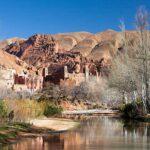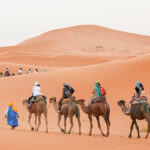The Sahara Desert, often envisioned as a vast, sandy expanse, holds secrets and surprises that defy common misconceptions. For those captivated by the allure of Earth’s natural wonders, the Sahara presents a landscape rich with history, ecological diversity, and geological marvels. Here, we explore 15 intriguing facts about the Sahara Desert, shedding light on its true grandeur. This journey through the desert is brought to you by Marrakech Desert Trips, your gateway to organizing magical Morocco Desert Tours.
In this article:
- 1. Understanding the Sahara: The World’s Largest Hot Desert
- 2. The Vast Expanse: How Big is the Sahara Desert?
- 3. The Origin of ‘Sahara’: What’s in a Name?
- 4. Saharan Sand Dunes: Nature’s Skyscrapers
- 5. Life in the Sahara Desert: Adaptation and Survival
- 6. Temperature Extremes: Surviving the Sahara’s Heat
- 7. Prehistoric Sahara: A Haven for Dinosaur Fossils
- 8. Rock Over Sand: The Surprising Terrain of the Sahara
- 9. Emi Koussi Volcano: The Sahara’s Tallest Peak
- 10. Wildlife of the Sahara: Diversity Among the Dunes
- 11. Water in the Desert: Exploring the Sahara’s Lakes and Oases
- 12. The Sahara in Hollywood: A Star Wars Filming Location
- 13. Climate Change and the Expanding Sahara
- 14. The Sahara’s Climate Cycle: From Desert to Grassland
- 15. Touring the Sahara: Top Activities and Experiences
1. Understanding the Sahara: The World’s Largest Hot Desert
Contrary to popular belief, the Sahara is not the world’s largest desert. It ranks third after the cold deserts of Antarctica and the Arctic. However, it holds the title of the largest hot desert on the planet.


2. The Vast Expanse: How Big is the Sahara Desert?
The Sahara covers an astonishing 9.2 million square kilometers, stretching across much of North Africa. This makes it almost as large as the United States!
3. The Origin of ‘Sahara’: What’s in a Name?
The name ‘Sahara’ is derived from the Arabic word ‘Sahra,’ meaning ‘desert’. This tautological name emphasizes its defining aridness.


4. Saharan Sand Dunes: Nature’s Skyscrapers
The dunes of the Sahara, known as ergs, can reach impressive heights of up to 180 meters — nearly half as tall as the Empire State Building!
5. Life in the Sahara Desert: Adaptation and Survival
Despite its harsh conditions, the Sahara is home to several resilient communities. Nomadic tribes such as the Tuareg and the Berbers traverse these arid lands, adapting to one of Earth’s most extreme environments.


6. Temperature Extremes: Surviving the Sahara’s Heat
During summer, temperatures in the Sahara can soar to between 38-46°C (100-115°F), creating an almost otherworldly landscape of heat and sand.
7. Prehistoric Sahara: A Haven for Dinosaur Fossils
The Sahara was once a much wetter place, where numerous dinosaur fossils have been discovered, providing a window into its prehistoric past.


8. Rock Over Sand: The Surprising Terrain of the Sahara
Contrary to the common image of a sandy desert, the Sahara is predominantly rocky. Sand seas or ergs cover only about 25% of the desert’s surface.
9. Emi Koussi Volcano: The Sahara’s Tallest Peak
The highest point in the Sahara is the Emi Koussi volcano in Chad, which towers at 3,415 meters above sea level.


10. Wildlife of the Sahara: Diversity Among the Dunes
The wildlife in the Sahara includes more than just camels and goats. From the swift-footed gazelles to the elusive cheetah and the small, adaptive Fennec fox, the desert brims with life.
11. Water in the Desert: Exploring the Sahara’s Lakes and Oases
Contrary to its dry reputation, the Sahara boasts over 20 lakes and numerous oases, which serve as vital water sources and havens for wildlife and humans alike. Additionally, the ingenious Khettara underground irrigation systems, a traditional method developed centuries ago, play a crucial role in distributing water in this arid region. These subterranean channels effectively bring groundwater to the surface, supporting agriculture and sustaining life even in the harshest environments. The integration of Khettara systems highlights the adaptability and ingenuity of desert dwellers in managing scarce water resources.


12. The Sahara in Hollywood: A Star Wars Filming Location
The Sahara has captured the imaginations of filmmakers, notably serving as a filming location for the Star Wars saga. The desert landscapes of Tunisia became iconic through their depiction of Tatooine.
13. Climate Change and the Expanding Sahara
Recent studies suggest that the Sahara has expanded by 10% in the last century, influenced by both natural climatic fluctuations and human-driven climate change.


14. The Sahara’s Climate Cycle: From Desert to Grassland
Every 41,000 years, the Sahara undergoes dramatic transformations from desert to savanna grassland, due to shifts in Earth’s axis that affect the North African Monsoon.
15. Touring the Sahara: Top Activities and Experiences
Visitors can engage in a variety of things to do in the Sahara Desert, from camel trekking and sandboarding to exploring ancient ruins and star-gazing under one of the clearest night skies in the world.

Embark on an unforgettable journey into the heart of the Sahara with Marrakech Desert Trips. Experience the magic of the desert, where every grain of sand tells a story and every sunrise brings a new adventure. For those looking to explore this extraordinary desert, remember that the Sahara, with its vastness and mystery, offers an adventure that is truly timeless.




































